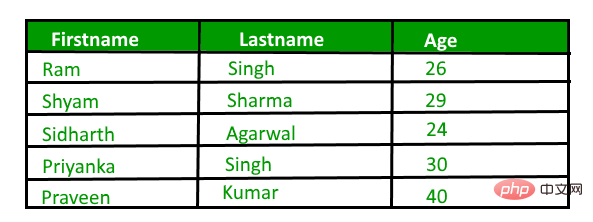Detailed explanation of limit usage in PHP mysql (code example)
In MySQL, the LIMIT clause is used with the SELECT statement to limit the number of rows in the result set. The LIMIT clause accepts one or two parameters, offset and count. The value of both parameters can be zero or a positive integer.

offset: Used to specify the offset of the first row to be returned.
Count: Used to specify the maximum number of rows to be returned.
The Limit clause accepts one or two parameters. When two parameters are specified, the first parameter is the offset, and the second parameter represents the count. When only one parameter is specified, it represents the starting point. The number of rows to start returning in the result set.
LIMIT syntax:
SELECT column1, column2, ... FROM table_name LIMIT offset, count;
The following table "Data" contains three columns "Firstname", "Lastname" and "Age".

To retrieve the first three rows from the "Data" table, we will use the following query:
SELECT * FROM Data LIMIT 3;
To retrieve the 2nd row from the "Data" table -3 lines (inclusive), we will use the following query:
SELECT * FROM Data LIMIT 1, 2;
The following is a code example for PHP mysql to implement the query:
Example 1: Limit condition
<?php
$link = mysqli_connect("localhost", "root", "", "Mydb");
if ($link == = false) {
die("ERROR: Could not connect. ".mysqli_connect_error());
}
$sql = "SELECT * FROM Data LIMIT 2";
if ($res = mysqli_query($link, $sql)) {
if (mysqli_num_rows($res) > 0) {
echo "<table>";
echo "<tr>";
echo "<th>Firstname</th>";
echo "<th>Lastname</th>";
echo "<th>Age</th>";
echo "</tr>";
while ($row = mysqli_fetch_array($res)) {
echo "<tr>";
echo "<td>".$row['Firstname']."</td>";
echo "<td>".$row['Lastname']."</td>";
echo "<td>".$row['Age']."</td>";
echo "</tr>";
}
echo "</table>";
mysqli_free_result($res);
}
else {
echo "No matching records are found.";
}
}
else {
echo "ERROR: Could not able to execute $sql. ".mysqli_error($link);
}
mysqli_close($link);Output:

Note: The "res" variable stores the data returned by the function mysql_query().
Every time mysqli_fetch_array() is called, it returns the next row from the res() set.
The while loop is used to traverse all rows of the table "data".
Example 2: Limit clause using object-oriented approach
<?php
$mysqli = new mysqli("localhost", "root", "", "Mydb");
if ($mysqli == = false) {
die("ERROR: Could not connect. ".$mysqli->connect_error);
}
$sql = "SELECT * FROM Data LIMIT 2";
if ($res = $mysqli->query($sql)) {
if ($res->num_rows > 0) {
echo "<table>";
echo "<tr>";
echo "<th>Firstname</th>";
echo "<th>Lastname</th>";
echo "<th>Age</th>";
echo "</tr>";
while ($row = $res->fetch_array()) {
echo "<tr>";
echo "<td>".$row['Firstname']."</td>";
echo "<td>".$row['Lastname']."</td>";
echo "<td>".$row['Age']."</td>";
echo "</tr>";
}
echo "</table>";
$res->free();
}
else {
echo "No matching records are found.";
}
}
else {
echo "ERROR: Could not able to execute $sql. ".$mysqli->error;
}
$mysqli->close();Output:

Example 3: Limit clause using PDO method
<?php
try {
$pdo = new PDO("mysql:host=localhost;dbname=Mydb", "root", "");
$pdo->setAttribute(PDO::ATTR_ERRMODE, PDO::ERRMODE_EXCEPTION);
}
catch (PDOException $e) {
die("ERROR: Could not connect. ".$e->getMessage());
}
try {
$sql = "SELECT * FROM Data LIMIT 2";
$res = $pdo->query($sql);
if ($res->rowCount() > 0) {
echo "<table>";
echo "<tr>";
echo "<th>Firstname</th>";
echo "<th>Lastname</th>";
echo "<th>Age</th>";
echo "</tr>";
while ($row = $res->fetch()) {
echo "<tr>";
echo "<td>".$row['Firstname']."</td>";
echo "<td>".$row['Lastname']."</td>";
echo "<td>".$row['Age']."</td>";
echo "</tr>";
}
echo "</table>";
unset($res);
}
else {
echo "No matching records are found.";
}
}
catch (PDOException $e) {
die("ERROR: Could not able to execute $sql. ".$e->getMessage());
}
unset($pdo);Output:

Related recommendations:《 mysql tutorial》
This article is about the detailed usage of limit in mysql. I hope it will be helpful to friends in need!
The above is the detailed content of Detailed explanation of limit usage in PHP mysql (code example). For more information, please follow other related articles on the PHP Chinese website!

Hot AI Tools

Undresser.AI Undress
AI-powered app for creating realistic nude photos

AI Clothes Remover
Online AI tool for removing clothes from photos.

Undress AI Tool
Undress images for free

Clothoff.io
AI clothes remover

Video Face Swap
Swap faces in any video effortlessly with our completely free AI face swap tool!

Hot Article

Hot Tools

Notepad++7.3.1
Easy-to-use and free code editor

SublimeText3 Chinese version
Chinese version, very easy to use

Zend Studio 13.0.1
Powerful PHP integrated development environment

Dreamweaver CS6
Visual web development tools

SublimeText3 Mac version
God-level code editing software (SublimeText3)

Hot Topics
 1655
1655
 14
14
 1413
1413
 52
52
 1306
1306
 25
25
 1252
1252
 29
29
 1226
1226
 24
24
 MySQL's Role: Databases in Web Applications
Apr 17, 2025 am 12:23 AM
MySQL's Role: Databases in Web Applications
Apr 17, 2025 am 12:23 AM
The main role of MySQL in web applications is to store and manage data. 1.MySQL efficiently processes user information, product catalogs, transaction records and other data. 2. Through SQL query, developers can extract information from the database to generate dynamic content. 3.MySQL works based on the client-server model to ensure acceptable query speed.
 How to start mysql by docker
Apr 15, 2025 pm 12:09 PM
How to start mysql by docker
Apr 15, 2025 pm 12:09 PM
The process of starting MySQL in Docker consists of the following steps: Pull the MySQL image to create and start the container, set the root user password, and map the port verification connection Create the database and the user grants all permissions to the database
 Laravel Introduction Example
Apr 18, 2025 pm 12:45 PM
Laravel Introduction Example
Apr 18, 2025 pm 12:45 PM
Laravel is a PHP framework for easy building of web applications. It provides a range of powerful features including: Installation: Install the Laravel CLI globally with Composer and create applications in the project directory. Routing: Define the relationship between the URL and the handler in routes/web.php. View: Create a view in resources/views to render the application's interface. Database Integration: Provides out-of-the-box integration with databases such as MySQL and uses migration to create and modify tables. Model and Controller: The model represents the database entity and the controller processes HTTP requests.
 Solve database connection problem: a practical case of using minii/db library
Apr 18, 2025 am 07:09 AM
Solve database connection problem: a practical case of using minii/db library
Apr 18, 2025 am 07:09 AM
I encountered a tricky problem when developing a small application: the need to quickly integrate a lightweight database operation library. After trying multiple libraries, I found that they either have too much functionality or are not very compatible. Eventually, I found minii/db, a simplified version based on Yii2 that solved my problem perfectly.
 Laravel framework installation method
Apr 18, 2025 pm 12:54 PM
Laravel framework installation method
Apr 18, 2025 pm 12:54 PM
Article summary: This article provides detailed step-by-step instructions to guide readers on how to easily install the Laravel framework. Laravel is a powerful PHP framework that speeds up the development process of web applications. This tutorial covers the installation process from system requirements to configuring databases and setting up routing. By following these steps, readers can quickly and efficiently lay a solid foundation for their Laravel project.
 How to install mysql in centos7
Apr 14, 2025 pm 08:30 PM
How to install mysql in centos7
Apr 14, 2025 pm 08:30 PM
The key to installing MySQL elegantly is to add the official MySQL repository. The specific steps are as follows: Download the MySQL official GPG key to prevent phishing attacks. Add MySQL repository file: rpm -Uvh https://dev.mysql.com/get/mysql80-community-release-el7-3.noarch.rpm Update yum repository cache: yum update installation MySQL: yum install mysql-server startup MySQL service: systemctl start mysqld set up booting
 MySQL and phpMyAdmin: Core Features and Functions
Apr 22, 2025 am 12:12 AM
MySQL and phpMyAdmin: Core Features and Functions
Apr 22, 2025 am 12:12 AM
MySQL and phpMyAdmin are powerful database management tools. 1) MySQL is used to create databases and tables, and to execute DML and SQL queries. 2) phpMyAdmin provides an intuitive interface for database management, table structure management, data operations and user permission management.
 MySQL vs. Other Databases: Comparing the Options
Apr 15, 2025 am 12:08 AM
MySQL vs. Other Databases: Comparing the Options
Apr 15, 2025 am 12:08 AM
MySQL is suitable for web applications and content management systems and is popular for its open source, high performance and ease of use. 1) Compared with PostgreSQL, MySQL performs better in simple queries and high concurrent read operations. 2) Compared with Oracle, MySQL is more popular among small and medium-sized enterprises because of its open source and low cost. 3) Compared with Microsoft SQL Server, MySQL is more suitable for cross-platform applications. 4) Unlike MongoDB, MySQL is more suitable for structured data and transaction processing.




